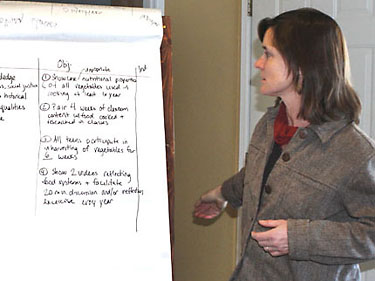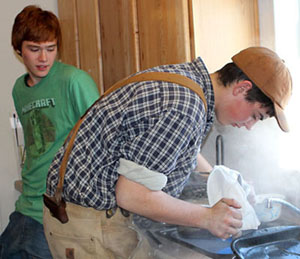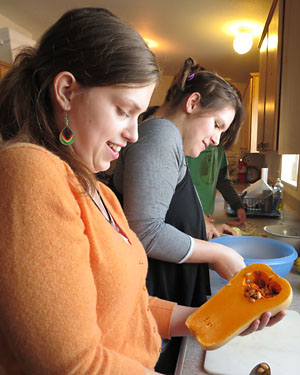home | internet service | web design | business directory | bulletin board | advertise | events calendar | contact | weather | cams

 Red Shed Director Kelleigh McMillan explains the cooking class goals for the Independent Learning Center's students. Photo by Solveig Torvik Red Shed Director Kelleigh McMillan explains the cooking class goals for the Independent Learning Center's students. Photo by Solveig TorvikSchooled Lunch Every Thursday, a group of high school kids gathers in Twisp for lunch. But they do more about their lunch than just eat it. They plant it. They cultivate it. They harvest it. And then they cook it, under the watchful eyes and gentle prodding of Room One’s Red Shed Director Kelleigh McMillan and her AmeriCorps assistant, Annie McKay. “A lot of times we don’t use a recipe,” says McMillan. But when they do, academic skills such as reading and math come into play. And the kids, who attend the Methow Valley School District’s Independent Learning Center and receive academic credit for the ILC Cooking Class, don’t just make food for themselves. They also prepare something that will be served on Friday nights at the Valley Teen Center at TwispWorks. On the day Grist visited the kitchen, students prepared squash soup for the center.  Justin Dunlap drains water off potatoes to be used for making gnocci (dumplings) as Jake Davie watches. Most of the students have been teen age boys. Photo by Solveig Torvik Justin Dunlap drains water off potatoes to be used for making gnocci (dumplings) as Jake Davie watches. Most of the students have been teen age boys. Photo by Solveig TorvikFor their own lunch, students tackled potato-based gnocchi (dumplings) with tomato sauce, augmented - to much applause from the cooks - by sweet Italian sausage donated by local butcher Chris Thompsen and expertly cooked up in the lively camaraderie of the bustling kitchen by Justin Dunlap, who works for Thompsen. But meat usually is not a starring item on the menus because the program has only $10 or less to spend each week on such staples as eggs and flour, says McMillan. “We have a small budget,” she explains, a situation that mirrors the stark reality of food budgets for many valley families. So an important component of the program is to show students how they can eat well on a limited budget. Much of the food cooked by the students is produce grown in the Red Shed’s organic garden, a one-acre plot at her commercial Sowing Seeds organic farm set aside in 2007 by McMillan to provide vegetables for patrons of Room One and The Cove Food Bank. A key goal of the class is to teach students to make good meals from healthy ingredients, she says. Other educational goals include nutritional literacy as well as comprehension of the food system and the social justice aspects of food economics - not exactly the Home Economics curriculum of days of yore.  Samantha Eiffert, front, and Julie McMillan prepare squash. Photo by Maria Converse Samantha Eiffert, front, and Julie McMillan prepare squash. Photo by Maria ConverseIn the fall, they even master the disappearing food preservation skills of their grandparents: canning vegetables for use during the program’s winter months. “All of them know about canning from their grandparents’ generation,” observes McMillan. “Most of the students have been teen-age boys,” McMillan adds. On the day of Grist’s visit, eight of the 10 students are boys, and two of them are crying - over the onions. “Only real men cry when they cut onions,” sniffs Jachin Anderson as he wipes his eyes on his sleeve. Asked what he likes best of the meals he’s learned to make in the three years he’s been coming to the class, Jesse Hope unhesitatingly answers: “Potato leek soup. It’s really easy but it’s really good.” McMillan says she was inspired to establish the Red Shed garden and the subsequent student gardening/cooking program when she realized the extent to which poverty among valley families was limiting their access to the kind of nutritious food she grows commercially. “It was hard to see that disparity,” she says. “Most people living in poverty do not have access to healthy food.” 1/12/2013 Comments
|